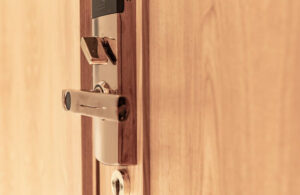Top Security Certifications for High-Security Locks Explained
Ever had that sinking feeling when you’re unsure if your high security door locks are actually, well, secure? It’s a bit like having an umbrella with holes in it during a downpour. You want to be sure those locks can withstand whatever comes their way. Enter ANSI/BHMA grading—a system that separates the wheat from the chaff.
So what’s this all about? The American National Standards Institute (ANSI) and Builders Hardware Manufacturers Association (BHMA) team up to create these grades. They put locks through rigorous tests—like they’re auditioning for a spy movie or something—to make sure they stand up to various forms of attacks and wear over time.
### Grade 1: The Heavyweight Champion
Grade 1 is where you find the Fort Knox of door hardware. These bad boys are tested to endure heavy use and serious attempts at forced entry. Imagine trying to break into a bank vault; that’s what these locks are built for. If you’re looking for top-tier protection, this is your go-to grade.
For instance, commercial buildings often use Grade 1 deadbolts because they’re subjected to thousands of cycles daily without faltering. Homeowners who prioritize safety above all else also lean towards these high-security options.
### Grade 2: The Reliable Workhorse
Next up is Grade 2, which strikes a balance between durability and cost-effectiveness. Think of it as the dependable sedan compared to the luxury sports car that is Grade 1—it gets the job done efficiently without breaking the bank.
These locks are perfect for residential settings or less demanding commercial applications like small offices or internal doors within larger facilities. They’re not invincible but offer substantial resistance against common threats like bumping or picking.
### Grade 3: The Everyday Defender
Finally, we have Grade 3—the minimum standard required by ANSI/BHMA but still reliable enough for many homes out there. This level provides basic security features suitable for areas with lower risk factors.
If you’ve got rooms inside your house needing just some simple locking mechanisms—think bedroom doors or storage spaces—Grade 3 fits perfectly here without costing an arm and a leg!
### What Do These Grades Mean For You?
Choosing between these grades depends on how much peace of mind you’re after—and maybe how paranoid you’ve become after binge-watching too many crime dramas! Jokes aside though:
– High-Risk Areas: Go straight-up James Bond with Grade 1.
– Moderate Risk: Opt-in favorably toward trusty old faithfuls in Grade 2.
– Low-Risk Zones: Save yourself some cash while keeping things safe using Grade 3 products.
It’s crucial not only knowing about these certifications but understanding why they matter so much in everyday life scenarios—from protecting loved ones at home down right safeguarding business assets securely!
When you’re picking out locks, remember that these grades are more than just numbers—they’re your first line of defense. Whether it’s keeping the bad guys out or ensuring a stubborn teenager doesn’t sneak out at night, choosing the right grade makes all the difference.
What UL 437 Certification Means for Your Lock’s Security
When it comes to high security door locks, understanding certifications can feel like trying to crack a safe without the combination. But fear not! We’re here to demystify one of the most critical badges your lock can earn: UL 437 certification.
Picture this: You’ve just moved into a new house, and you want Fort Knox-level protection for your front door. A friend mentions UL 437 certified locks, but what does that even mean? Is it just another fancy label or something more substantial?
UL (Underwriters Laboratories) is an independent organization that sets rigorous standards for products in various industries. When a lock earns the UL 437 certification, it’s been tested against some pretty harsh criteria. Think of it as sending your lock through boot camp—only the toughest survive.
To snag this certification, locks undergo tests designed to challenge their resistance against picking, drilling, and other forms of tampering. Imagine trying to break into Fort Knox with nothing but a bobby pin; that’s how tough these tests are!
So why should you care about all this? Well, if you’re looking at high-security options for your home or business, knowing whether a lock has passed these stringent tests gives you peace of mind. It means someone out there tried every trick in the book—and failed miserably—to compromise its integrity.
Now let’s get down to brass tacks and talk specifics:
1. Picking Resistance: Remember those spy movies where they pick locks with ease? Not happening here! Locks under UL 437 scrutiny must withstand advanced picking techniques used by professional locksmiths.
2. Drilling Resistance: No drill bits making Swiss cheese out of these bad boys! The material and design have got fortifications specifically aimed at thwarting drilling attempts.
3. Physical Strength: We’re talking brute force attacks too—hammer blows, wrenching forces—you name it.
One anecdote from my buddy who works as a locksmith always cracks me up (pun intended). He once had a client who was so paranoid about security that he installed multiple layers of defense on his doors—deadbolts upon deadbolts—but none were UL certified! One day during routine maintenance checks, my friend managed to pick them all within minutes using basic tools!
Moral of the story? All those bells and whistles don’t matter if they can’t stand up when push comes to shove—or rather when someone’s shoving their way inside.
Alright, let’s keep this train rolling. You might be wondering if all locks with a UL 437 certification are created equal. The short answer is no. Even within the certified bunch, there are varying levels of security features and materials used.
Think about it like buying a car. Just because two vehicles have passed safety tests doesn’t mean they offer the same level of protection or performance. One might come with bulletproof glass while another has standard windows—both safe but in different leagues.
A quick chat with your local locksmith can shed light on which UL 437 certified lock fits your needs best. Some models come loaded with additional bells and whistles like anti-bump pins or reinforced strike plates that make them even tougher to breach.
And don’t forget maintenance! Even the most secure lock needs some TLC now and then to stay in tip-top shape. Regularly lubricate moving parts and check for wear and tear—it’s kind of like taking your car for an oil change; small efforts go a long way in keeping things running smoothly.







